
Calcium and hard water can build up on your faucets, and if it is left to accumulate it can be hard to remove. That is why it is a good practice to regularly clean your faucets. If you are confused about which products to use to clean your faucet, then do not worry. This guide will surely resolve any uncertainty you might have regarding the maintenance of your faucet.
You can use a variety of common household products like baking soda, white vinegar, dish soap, lemon, toothpaste, Clorox wipes, and even ketchup to clean your faucets and rid them of stains, grime, and hard water spots. However, avoid harsh chemicals like ammonia or abrasive tools like steel wools as they can quite easily destroy the whole faucet.
Even if you know which products to use, without knowing the proper procedure to use these products, you might not be able to effectively clean your faucets. That is why it is essential to know the right method so that you can achieve your desired results.
This article and its contents are owned by Wabi Sabi Group and was first published on 06/13/2022.
Can You Use Vinegar To Clean a Faucet?
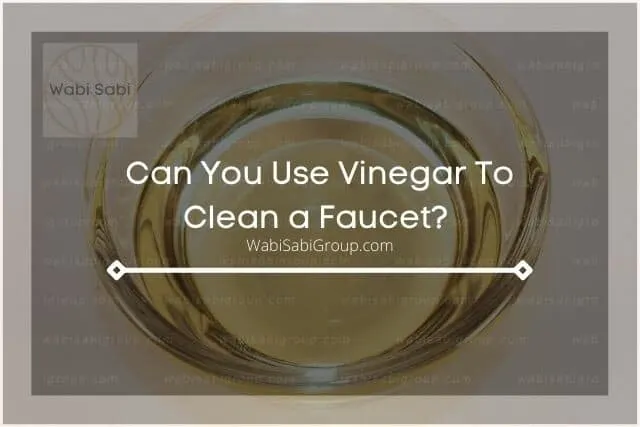
Although vinegar is a popular condiment, it is also a great all-natural cleaning agent. It is widely used to clean various surfaces and appliances. But can it be used to clean faucets?
Vinegar is very effective at cleaning faucets. However, you should only use white vinegar to clean your faucet as regular vinegar may diminish the shine of the faucet. White vinegar is also a great disinfectant that will break up all mineral and calcium deposits on your faucet.
To clean the surface of the faucet all you have to do is to immerse a rag in white vinegar, and drape it over the faucet for 30 minutes. After that use a towel or a non-scratch sponge to scrub off the stains. But that is not all, you can also use vinegar to clean the head of the faucet.
How To Clean The Faucet Head Using Vinegar
If you follow a few simple steps, you can also use vinegar to clean and disinfect the head of the faucet.
Step 1: Acquire a plastic baggie and fill it halfway with white vinegar.
Step 2: Pull the baggie over the head of your faucet and secure it in place with multiple rubber bands. Make sure the faucet head is fully submerged in the vinegar and let it sit for 20-30 minutes.
Step 3: Once the time is up, remove the baggie and properly rinse off the faucet head with warm water.
Can You Use Baking Soda To Clean a Faucet?
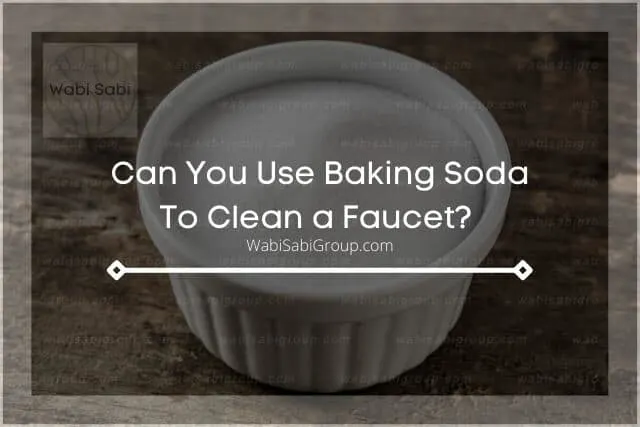
Unlike many cleaning products found on the market, baking soda is a natural and non-toxic cleaning agent which is great at removing grease and dirt from various surfaces. But is baking soda just as effective at removing rust, and limestone buildup from your faucets?
Baking soda is excellent at removing rust, grease, and limestone build-up from your faucets. The alkalic nature of baking soda also allows it to remove other hard-to-remove stains. Simply mix baking soda with some water and wipe your faucet clean.
Step-by-Step Guide On Using Baking Soda To Clean Dirty Faucet
Instead of opting for an expensive cleaner, you can simply use baking soda to clean your faucet by following a few simple steps.
Step 1: Mix 2 tbsp of baking soda in a quarter glass of water. You can also add some dishwashing liquid or vinegar into this solution if you are facing difficulties removing the stains.
Step 2: Mix the solution well enough so that you end up with a thick paste. The thicker the paste is, the easier it would be for you to scrub off the rust from the faucet.
Step 3: Now, apply the paste you just created on your faucet. Wait for a couple of minutes before scrubbing the faucet with a microfibre cloth or a brush. You’ll start noticing the rust disappearing.
Step 4: Don’t stop scrubbing until you’re happy so. Once you’re satisfied, wash the faucet with water and clean it using a dry cloth.
This article and its contents are owned by Wabi Sabi Group and was first published on 06/13/2022.
Can You Use CLR To Clean a Faucet?
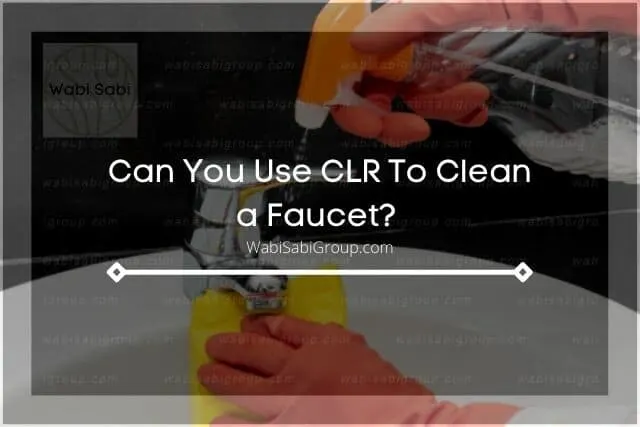
CLR is one of the best limescale and calcium removers. If your faucet has excessive buildup which you want to get rid of quickly, then using a CLR might be your best option.
The acidic properties of CLR can effectively dissolve all calcium deposits and soap scum from your faucet. However, CLR is only recommended to be used on faucets made of stainless steel or chrome. Other metallic finishes can often get ruined due to the abrasive properties of CLR.
How To Clean Your Faucet Using CLR
If you want to get rid of those deposits but don’t want to chip away at them, here’s an easier approach involving CLR, a plastic bag, a rubber band, some water, and a sponge.
Step 1: Pour some CLR into the plastic bag and add an equal quantity of water for a one-to-one ratio. Then, using a rubber band, secure the bag around the tip of the faucet. Allow it to work for a few hours.
Step 2: After the CLR has had a few hours to work, remove the bag. You’ll still notice the buildup, but don’t worry! This is the time to pull out a sponge. Use the sponge to scrub the faucet, and you’ll see the gunk disappearing in no time!
Step 3: Finally, rinse the faucet using clean water to ensure that no CLR residue remains on the surface.
Can You Use Apple Cider To Clean Faucets?
You can use apple cider to clean the faucet. To do that, take a plastic bag and add a quarter cup of baking soda, one part apple cider, and one part water. Submerge the faucet in the bag and secure it with a rubber band. After 15 minutes, you’ll start noticing the stains diminishing.
Can You Use Lemon To Clean Faucets?
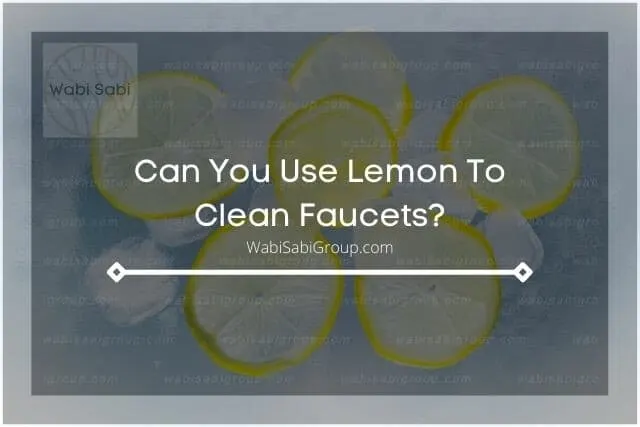
Lemons are incredibly useful for cleaning various appliances and surfaces. Their acidic properties can quickly dissolve grime and dirt, and leave behind a wonderful scent! Sounds like a perfect cleaner for faucets right?
Indeed, lemons are incredible at cleaning faucets. They are naturally effective at removing stains and limescale buildup from your faucets. They perform a much better job at wiping away stains than some of the most expensive cleaners available on the market.
Guide On Using Lemons For Cleaning Faucets
Some people might get confused over how to employ lemons to clean various appliances such as faucets. That’s exactly why I’ve prepared a step-by-step guide to explain to you everything you need to do to achieve a sparkling faucet
Step 1: Using a kitchen knife, cut a lemon in half crosswise. As long as the lemon is still fresh and contains a good amount of juice, this method will work fantastically.
Step 2: Directly place one-half of the lemon on the faucet and rub it over the stains you want to remove. If you want to remove the limescale from the tip of the faucet then place one-half of the lemon underneath the faucet head and rub it. Make sure that you cover the limescale completely with lemon juice so that the acidic liquid can decompose the buildup.
Step 3: After that let the lemon juice sit overnight to allow the lemon juice to release the buildup. If you’re in a hurry, you can check the faucet after a few hours to see whether the buildup is being removed by wiping the faucet with a towel.
Step 4: Scrub away any leftover gunk with a toothbrush
Step 5: Now all that’s left to do is wash the faucet. For this purpose use warm water and a clean towel. Once you are done rinsing, you’ll instantly notice that all stains and limescale buildup are dissolved.
This article and its contents are owned by Wabi Sabi Group and was first published on 06/13/2022.
Can You Use Toothpaste To Clean a Faucet?
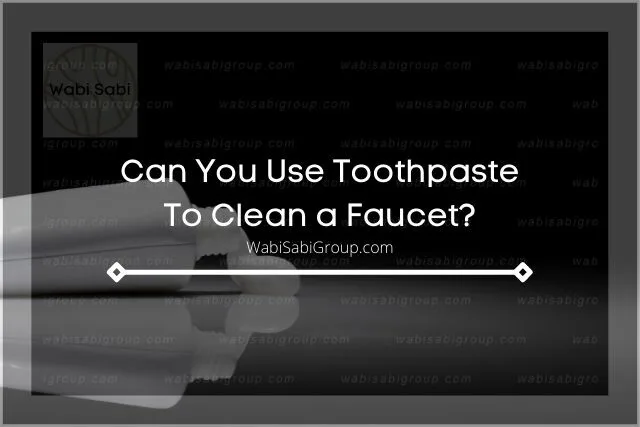
We know that toothpaste is made to cleanse your teeth, but did you know that the same toothpaste can also clean a variety of surfaces around the house? Toothpaste contains baking soda, which makes it a mildly abrasive cleaner. This allows it to remove stains from anything from your ceilings to your shoes. So will it clean your faucet as well?
Toothpaste is great at removing hard water stains and restoring the shine of your faucet. Apply a dab of toothpaste in tiny circles and buff it using a clean cloth before rinsing it off. However, keep in mind that toothpaste can also degrade the shine of the faucet if you use it frequently.
Can You Use Bleach To Clean a Faucet?
I can’t be the only one who has thought about cleaning a faucet with bleach. I was unsure whether it would work. However, since bleach is incredibly powerful at destroying germs and various viruses, I decided to give it a chance and I wasn’t thrilled with the results.
You should not use bleach to clean your faucet as it is extremely harmful to the surface of the faucet, especially on stainless steel. This is because the hydrochloric and sulfuric acid found in bleach can damage the protective layer of stainless steel and corrode it. However, if you dilute bleach with water you can use it as a disinfectant.
Drawbacks Of Using Bleach
It is already established that bleach is very dangerous for your faucet. However, there’s more to it than just that. If bleach somehow ends up in your drain while cleaning, it can react with other chemicals and emit harmful odors.
Moreover, bleach can also discolor your faucet if it’s made of stainless steel. It corrodes the protective coating of the faucet and leaves your faucet in a worse condition than before.
However, you can use bleach as a disinfectant if you believe it’s heavily contaminated with germs and bacteria. To do this, create a solution using a quart of water and 1 tbsp of bleach. Use a clean rag to wipe the faucet with the solution and dispose of it afterward.
This article and its contents are owned by Wabi Sabi Group and was first published on 06/13/2022.
Can You Use WD-40 To Clean Faucets?
WD-40 is a popular chemical cleaner that is useful for cleaning various appliances. It is very effective in removing oil, grime, and other pollutants from most surfaces. So is wd-40 a good choice for cleaning faucets?
You can use WD-40 to clean your faucet. Simply apply some WD-40 on a clean cloth and use it to wipe away the faucet. With this, you will get rid of the most stain marks and rust from the surface of the faucet. However, the drawback of using WD-40 is that it will attract more dirt to stick to the surface.
Benefits and Drawbacks of WD-40
WD-40 is universally perceived as a great cleaning product. However, it has certain drawbacks that you need to be wary of when using it to clean your faucet.
|
Benefits of WD-40 |
Drawbacks of WD-40 |
|
Great for preventing rusting |
Not a good lubricant |
|
Will break down grease marks |
Leaves behind a very displeasing smell |
|
Protects the faucet from corrosion |
Can cause respiratory irritations |
|
Good for removing paint |
Gets easily washed away by water |
Can You Use Ketchup To Clean Faucets?
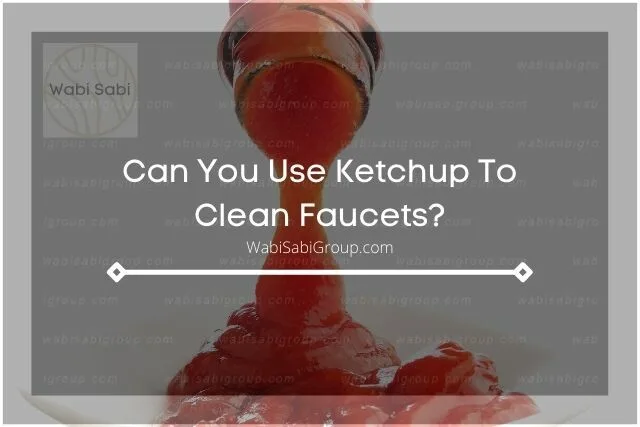
Spilling ketchup on a surface isn’t as bad as it’s made out to be. Ketchup is an excellent cleaning agent that can be used to clean metal surfaces, appliances, and even utensils. However, can ketchup actually clean your faucet?
You can clean your faucet using ketchup, as surprising as it may sound. This is because ketchup contains acetic acid, which is known to be effective at removing stains. Ketchup can get rid of those ugly black scum marks and the hard water buildup around the faucet.
The cleaning procedure is quite simple. Simply apply a large amount of ketchup around the base of the faucet and over it and let it work its magic.
After a few hours, gently wipe or rub the area using a clean rag before washing away the ketchup along with the stain marks. The result you will get is a gleaming faucet that almost looks brand new!
Can You Use Clorox Wipes To Clean a Faucet?
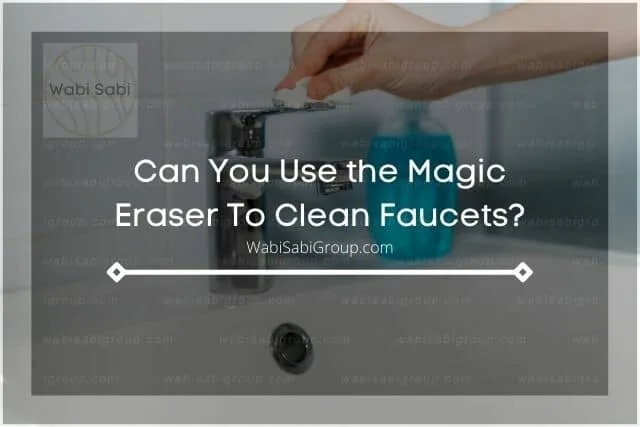
Before the pandemic, Clorox Wipes weren’t as common as they are now. Their cleaning and disinfecting properties make them incredibly useful for cleaning non-porous surfaces. So can Clorox wipe clean faucets as well?
Clorox Wipes are great for sanitizing and cleaning your faucets. This is because Clorox Wipes contain antimicrobials that effectively break down grease marks and leave behind a spotlessly clean-looking faucet. However, these disinfecting wipes can cause allergic reactions, so they must be used with care.
Using a Clorox wipe is pretty straightforward. All you have to do is use the wipes to scrub the length of the faucet and Voila! You’ll have a shining surface in no time.
This article and its contents are owned by Wabi Sabi Group and was first published on 06/13/2022.
Can You Use the Magic Eraser To Clean Faucets?
The sight of a dirty faucet is very repulsive. That is why people use several ways and products to clean their faucets, including magic erasers.
You can use magic erasers to clean your faucets as they are very effective at getting rid of hard water stains and other impurities from your faucets. They also have the added capability of sterilizing all kinds of bacteria present on the surface of the faucet.
How To Clean Your Faucets Using Magic Erasers
The procedure to clean your faucet is quite simple. All you need to do is to follow the few simple steps I have laid out for you.
Step 1: Dip the magic eraser in clean water.
Step 2: After you get the magic eraser wet, squeeze it at least three times so that you drain the water out.
Step 3: With the sponge in hand, rub the entire surface of the faucet. Make sure to pay special attention to heavily stained spots.
Step 4: Once you have gotten rid of all the stains, rinse the faucet with water and dry it with a towel.
Can You Use Rub And Buff To Clean Faucet?
As the name implies, Rub and Buff is a pretty simple product to use. Usually used as a shiner, you simply apply the paste on a clean and dry surface and rub it until you’re left with a glistening result. However, can Rub and Buff effectively produce sparkling clean faucets as well?
This content is owned by Wabi Sabi Group and was first published on Jun 13, 2022..
Rub n Buff is great for giving a new look to your faucets, especially if it’s constructed of chrome. The metallic wax finish hosts a strong pigment that is effectively attached to your faucet, giving it a brand new look. The paste is ideal for eliminating small details and avoiding the use of spray paint.
Sand the faucet using sandpaper and apply the Rub n Buff on it in minor strokes using a foam brush until the entire faucet is covered. Let it dry for at least half an hour before you rinse it clean to achieve a brand new faucet!
Can You Use Plumbers Putty To Clean Faucet?
Plumber’s putty is a malleable, soft-sealing substance used to create watertight seals around plumbing components such as faucets. It’s been used for decades by plumbers for various tasks, leaving me to wonder if it’s a viable cleaning solution for my home’s faucets.
No, Plumber’s putty is not used for cleaning in any way and shouldn’t be used on a faucet either. The Plumber’s putty is a sealant that is made specifically to seal the surface of faucets to prevent any sort of water leakage. Apart from solving your leakage problems, the putty has no business near a faucet.
This article and its contents are owned by Wabi Sabi Group and was first published on 06/13/2022.
How To Properly Clean Your Faucet
We all know how quickly bathroom faucets can get soiled and dirty after only a few days of cleaning. Toothpaste, detergent, hair, and other filth can rapidly accumulate and render your faucet unusable. Therefore, it’s essential to know about the proper method and tools involved in maintaining a sparkling clean faucet.
To clean your faucet properly, you need dish soap, white vinegar, an old toothbrush, and some non-abrasive cleaners. However, before proceeding, consult your faucet manufacturer’s instructions since some faucets are constructed of chrome and might require special care.
Step-By-Step Guide To Clean Your Faucets Properly
Once you’ve gathered all the required equipment, it’s time to get started. Here is a tried and tested method to clean your faucets perfectly so that you don’t end up repeating the process again in a few days’ time:
Step 1: Start off by cleaning the faucet using a solution of plain water and dish soap. You can also use a microfiber cloth to get rid of the surface dirt.
This will also allow you to buff the shine of the faucet and prevent spots from forming on the surface in the later stages.
Step 2: Once you’re done prepping your faucet, it’s time to create a mixture of white vinegar and water in a 1:2 ratio.
Step 3: Next, dip a cleaning cloth in this mixture and scrub the faucet with it.
If you want to be extra cautious, apply this solution to the back of your faucet to ensure that the solution is not harmful to your faucet’s finish.
Once you’re done wiping your faucet with your solution-dripping cloth, it’s time to go into the details.
Step 4: Clean the edges of your faucet using a toothbrush to rid them of any bacteria and grime buildup. You can use your water-dish soap solution to dab your brush in to achieve the best result.
This article was first published on Jun 13, 2022 by Wabi Sabi Group..
Once you’re done, wipe down your faucet with a clean dry towel and you’re ready to stare at a glistening masterpiece!
Related Articles
What Can You Use To Clean Kitchen Sink?
What Can You Use To Clean Stove Top Glass?
Can You Remove Rust From Porcelain? (How To)
What Can You Use To Clean Marble Countertops? (How To)
WabiSabi Group is the owner of this article and was published on Jun 13, 2022 and last modified on .
